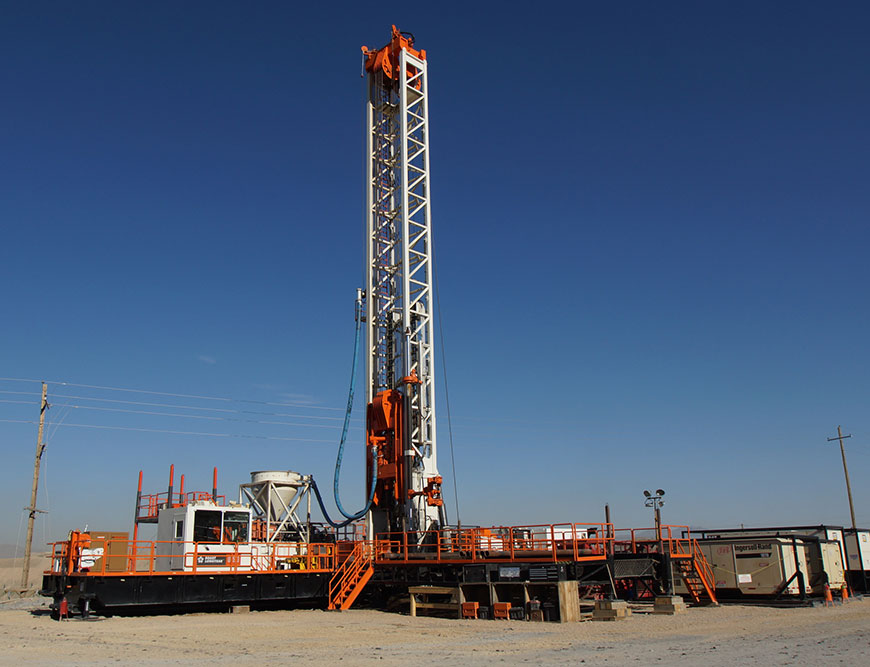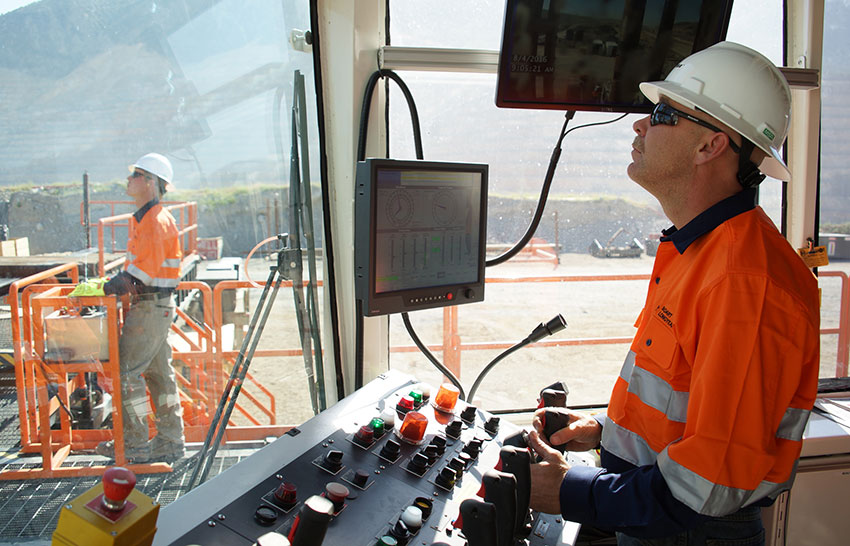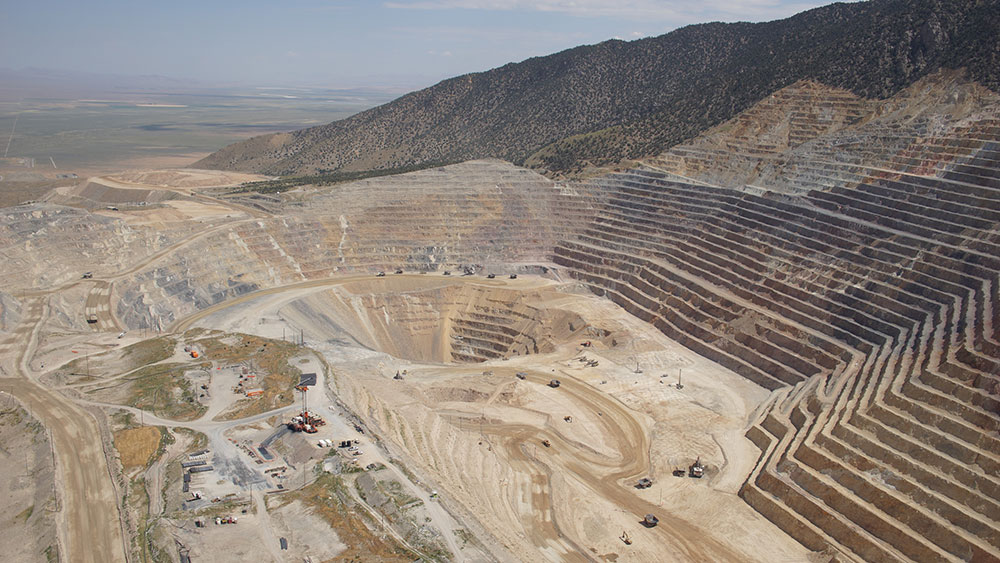BETRIEB MINE
10. Januar 2018
Das Boart Longyear LR ™ 500 - ein Rigg, mit dem sie alle konkurrieren können
| Rig-Länge | 125 Fuß | Rig-Breite | 12 Fuß |
| Rig Höhe | 16,5 Fuß | Bruttogewicht | 313.000 Pfund |
| Masthöhe | 98 Fuß | Hydraulischer Rückzug | 500.000 Pfund |
| Drehmoment | 29.000 Pfund | Drehgeschwindigkeit | 0 - 120 U / min |
| Generator Leistung | 1,300 | Pad-Abmessungen | 200 x 250 Fuß |
Seit 1890 transformiert Boart Longyear die Bohrindustrie mit Innovationen wie dem drahtgebunden für eine schnellere Kernwiederherstellung Zweirohr-geflutete Umkehrbohrung, und Schallbohrung für Bergbauanwendungen.
A global and dedicated engineering department works tirelessly to improve safety, increase productivity, and solve drilling challenges in collaboration with drillers and operations. Both Boart Longyear™ Bohrdienstleistungen und Boart Longyear Produkte Divisionen profitieren von der Möglichkeit, mit einem globalen Team von Ingenieuren beim Design von Geräten und Prototypen zusammenzuarbeiten.
Für die Große Drehbohrdienste division, the engineering team makes incredibly powerful and advanced rigs like the LR™500 possible. Recognizing Boart Longyear’s LR™300 had depth and pullback limitations, the engineering team built the significant and incredibly powerful LR500. Completely designed and developed internally, the LR500 was built specifically to meet the increasing needs for deeper dewatering wells for Nevada mining.
Es gibt zwar Tiefbohrgeräte auf dem Markt, aber nicht alle können ein Loch mit einem Durchmesser von 60 Zoll (152 Zentimeter) für Entwässerungsbohrungen für Minen erreichen. Mit dem LR500 können Lochgrößen gebohrt werden, die groß genug sind, um 20 Zoll (50 Zentimeter) Gehäuse bis zu 1.524 Meter (5.000 Fuß) aufzunehmen. Zwar gibt es Bohrgeräte auf dem Öl- und Gasmarkt, die zu einem stärkeren Rückzug in der Lage sind, diese schlanken Lochbohrgeräte sind jedoch nicht in der Lage, die mit dem LR500 erreichbaren Durchmesser zu bohren, und sie können auch das Gehäuse installieren.
Die Größe und das Gewicht des Gehäuses unterscheidet den LR500 von anderen großen Drehbohrgeräten der Branche.
Die Größe und das Gewicht des Gehäuses unterscheidet den LR500 von anderen großen Drehbohrgeräten der Branche. Der LR500 kann mit einem Rückzug von 500.000 lbs (35714 Steinen) tiefer bohren. Durch diese Fähigkeit kann das Bohrgerät das Gehäuse setzen, ohne dass das Bohrgerät aus dem Loch bewegt werden muss und das Gehäuse mit einem Kran eingesetzt werden muss. Dies ist eine umfassende Einsparung von Zeit-, Arbeits- und Ausrüstungskosten für die Mobilisierung und Demobilisierung.
Ein weiterer wesentlicher Vorteil des LR500 ist die elektrische Stromversorgung. Es verbindet sich nahtlos mit dem Stromnetz. Diese Technologie bietet einen erheblichen Vorteil für die Reduzierung von Emissionen und Kraftstoffeinsparungen. Die Verringerung der Emissionen war für den Bergbau-Kunden in Nevada, der den LR500 in Betrieb nahm, äußerst wichtig.
Automatisierte Bohrfunktionen
Der LR500 ist mit Sensoren ausgestattet und liefert dem Bohrer ständige Echtzeit-Rückmeldung über die Bodenbedingungen, die in der gesamten Bohrung auftreten. Der Bohrer stellt die Bohrparameter ein und das Bohrgerät löst abhängig von diesen eingestellten Parametern Alarme aus oder schaltet ab. Wenn sich die Bohrbedingungen mit fortschreitendem Bohrloch ändern, z. B. wenn der Dreikegelbohrer eine Leerstelle trifft, löst das Bohrgerät einen Alarm aus oder wird heruntergefahren, damit der Bohrer die richtigen Einstellungen vornehmen kann.
Handhabung der Freisprechstange
Zusätzlich zu den automatisierten Bohrfunktionen ist der LR500 mit einem vollständig freihändigen Rutenhandler ausgestattet. Ein mechanischer Stangenarm nimmt eine Stange aus der Stangenhalterung und führt sie in den Mast ein, sodass der Kopf die Stange einfädeln kann. Diese Freisprech-Technologie ermöglicht das Herstellen oder Brechen von Stangen beim Ein- und Aussteigen. Dies ist ein wesentliches Sicherheitsmerkmal, das Bohrer und Bohrerassistenten von den Gefahren der Handhabung von Stangen, dem Herstellen und Brechen von Stangen und einer schwebenden Last einer Stange entfernt.
Ein Bohrer Rig
Bohrer befinden sich in einer klimatisierten Kabine und sind vor den Elementen geschützt. Mehrere Bildschirme und ein Kamerasystem ermöglichen es dem Bohrer, wichtige Bereiche der Bohranlage von der Kabine aus zu überwachen - wie Ziehwerke, Kopf, Rutenhandling, Arbeitsdeck, Schlammbehältersystem usw. Die Kabine ist außerdem mit einer Gegensprechanlage ausgestattet, die dies ermöglicht der Bohrer zur Kommunikation mit dem Crewdeck.
Die Bohrmethode - Zweirohr überflutet
Dieses einzigartige Bohrverfahren verwendet ein doppelwandiges Bohrrohr und ein Bohrfluid zusammen mit der Injektion von Luft, um Löcher mit großem Durchmesser zu bohren. Im Bohrstrang ermöglichen Perforationen, dass die Luft in die Mitte zurückkehrt und dem Weg des geringsten Widerstands folgt. Die Luft, die das innere Rohr nach oben strömt, evakuiert die Flüssigkeit innerhalb des Bohrrohrs, wodurch wiederum die Schlammflüssigkeit auf der Rückseite der Bohrstange das Loch nach unten über die Bohrmeißelfläche und zurück in die Mitte nach oben bewegen kann, wodurch die Stecklinge gebracht werden damit. Bei Verwendung von DTFR (Dual Tube Flooded Reverse) tritt Flüssigkeit in das Doppelrohrrohr zurück und kann nicht in die Formation entweichen. Anstatt Flüssigkeiten an der Oberfläche zu halten und im gesamten Bohrloch zirkulieren zu lassen, ermöglicht das DTFR das Bohren mit den Bohrlochflüssigkeiten auf ihrem natürlich vorkommenden Niveau.
Die meisten anderen Auftragnehmer bohren ein Pilotloch mit einem kleineren Durchmesser und gehen dann wieder hinein und bohren das Loch mit dem größeren Durchmesser erneut auf. Manchmal kann dies mehrere Durchgänge dauern. Das Schöne an DTFR ist die Fähigkeit, mit einem einzigen Durchgang große Durchmesser und Tiefen zu bohren. Dies verkürzt die Gesamtzeit, während der das Loch geöffnet ist, und verringert das Risiko des Zusammenbruchs und der Überflutung der Formation. DTFR ist nicht nur effizienter, sondern minimiert die Entwicklungszeit und maximiert die Effizienz des Bohrlochs.
In sich geschlossene Bohrflüssigkeiten
Boart Longyear verwendet ein in sich geschlossenes Bohrfluidsystem, bei dem die Bohrfluide an die Oberfläche zurückkehren und in einem Tank gesammelt werden, in dem das Schnittgut durch Schieferschüttelsiebe und Entschleifaggregate aus dem Fluid gestrippt wird im Bohrprozess wiederverwendet. Autarke Bohrtanks sorgen für die richtige Mischung und Wartung der Bohrflüssigkeiten und sparen Geld, da keine Grube erforderlich ist. Durch den Verzicht auf eine Grube zum Bohren von Flüssigkeiten wird die Größe des Bohrkissens reduziert, möglicherweise weniger Störungserlaubnisse erforderlich, und es ist nicht mehr erforderlich, eine Grube nachzufüllen.
Ergebnisse
Der LR500 hat die Erwartungen der Bohrer und Ingenieure übertroffen. Das erste gebohrte Loch war ein echtes gerades Loch und wurde in einem einzigen Durchgang ausgeführt. Es war äußerst wichtig, dass das erste Loch, das der LR500 gebohrt hat, außergewöhnlich gerade ist, da in extremer Nähe zu einem unterirdischen Bohrloch gebohrt wurde. Es bestand die reale Möglichkeit, diesen Abschnitt zu durchkreuzen und zu überfluten. Die Ergebnisse des LR500 beeindruckten jedoch sowohl den Kunden als auch die Bohrmaschinen. Die Fähigkeit, solche geraden Bohrungen auszuführen, wird drei Hauptmerkmalen zugeschrieben: den automatisierten Bohrfunktionen, einem elektrischen Hebezeug und den größeren Werkzeugen.
Die konstante Echtzeit-Rückmeldung während des Bohrens ermöglicht es dem Bohrer, während des Bohrens Anpassungen vorzunehmen, um sich ändernden Bedingungen während des Bohrens anzupassen. Der elektrische Lifter ermöglicht eine sehr begrenzte Steuerung für sofortige Anpassung der Gewichts- und Rotationsabstimmung. Je größer das Werkzeug, desto starrer ist es, so dass es ein geraderes Loch bietet. Die robuste Werkzeug- und Bohrlochbaugruppe maximiert das Potenzial für Lotstand und Ausrichtung.
Das nächste Loch
Nach Fertigstellung des ersten Lochs wurde der LR500 mit zusammengebautem Mast und Sockel im Feld bewegt. Dies ist eine Zeitersparnis, denn wenn Sie erst einmal vor Ort sind, müssen Sie das Rigg weniger auseinander nehmen, um das Loch zum Loch zu bewegen. Der LR500 wurde in etwa 3 Stunden um 1,5 Meilen bewegt. Das Rigg sitzt auf einer modifizierten Raupenhacke und wurde mit der für den Umzug benötigten Hilfsausrüstung entworfen.
Beim ersten Brunnen wurde traditioneller Kies verwendet. Im zweiten Brunnen ordnete der Kunde Glas SiLibeads® an, um das Bildschirmgehäuse, eine weitere einzigartige Komponente des Projekts, festzulegen. Die Filterpack-Glasperlen wurden durch Kies ersetzt, um die biologische Anhäufung zu minimieren, die Brunnenkapazität zu maximieren und Energie und Rückspülwasser zu sparen.
Lösungen. Integrität. Ergebnisse.
Egal, ob Sie einen Auftragnehmer für Mineralienexplorationsbohrungen, Wasserversorgung oder Produktionsbohrungen benötigen, Sie benötigen einen Bauunternehmer, der sich durch einen soliden Ruf auszeichnet und über Erfolgsbilanz für Sicherheit und innovative Lösungen verfügt. Boart Longyear arbeitet sicher mit Integrität und Bohrungen für Ergebnisse und liefert ständig innovative Lösungen für die technischsten Bohraufgaben in einigen der komplexesten Betriebsumgebungen auf der ganzen Welt. Der LR500 ist nur ein weiteres Beispiel dafür, wie wir dies durch unsere Investitionen in Sicherheit, Mitarbeiter und Ausrüstung erreichen.
BOHRDIENSTE FLOTTE TIEFE
Laden Sie die Flottendiagramme der Bohring-Services herunter, um die breite Palette von Dienstleistungen zu entdecken, die Boart Longyear bietet.
HERUNTERLADEN
[pardot-form height="770" id="2928" title="Download the Drilling Services Fleet Depth Chart"]
Medienerlaubnis: Boart Longyear gewährt Ihnen die sofortige Agentur zur erneuten Veröffentlichung dieses Artikels. Bitte geben Sie als Quelle Boart Longyear an und geben Sie gegebenenfalls einen Link zurück.






